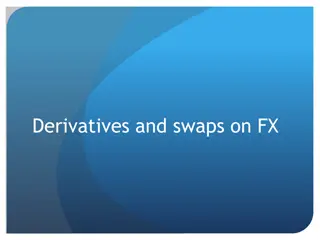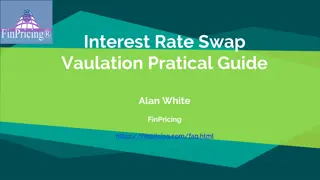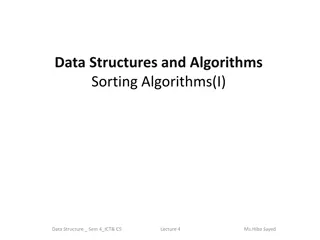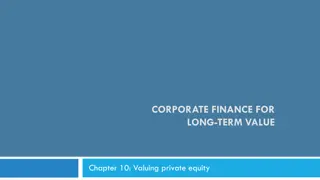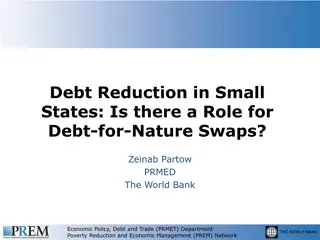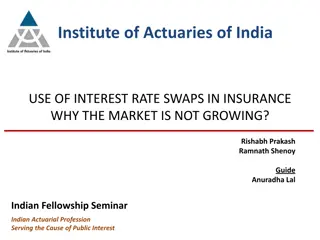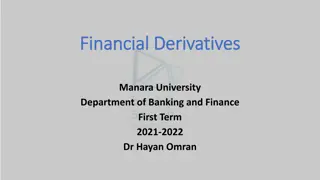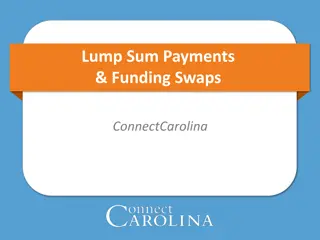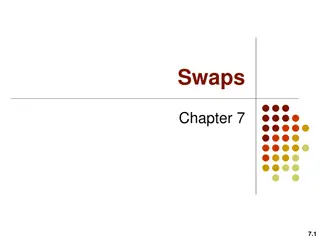
Understanding Equity Swaps: Purpose and Mechanics
Learn about the purpose and mechanics of equity swaps, a financial agreement that allows investors to exchange asset returns. Explore how equity swaps differ from interest rate swaps, and discover the implications of variable payments based on asset returns.
Download Presentation

Please find below an Image/Link to download the presentation.
The content on the website is provided AS IS for your information and personal use only. It may not be sold, licensed, or shared on other websites without obtaining consent from the author. If you encounter any issues during the download, it is possible that the publisher has removed the file from their server.
You are allowed to download the files provided on this website for personal or commercial use, subject to the condition that they are used lawfully. All files are the property of their respective owners.
The content on the website is provided AS IS for your information and personal use only. It may not be sold, licensed, or shared on other websites without obtaining consent from the author.
E N D
Presentation Transcript
Equity Swaps: Their purpose and mechanics
Example Suppose that a mutual fund manager for a well-diversified asset allocation fund believes that the U.S. equity market will perform poorly over the next year. Therefore, it wishes to reduce the equity exposure of its fund by $100 million. This money will be invested in an investment grade bond with a fixed rate. What are the fund s choices?: 1) Sell $100 million worth of equity and reinvest in a fixed-rate bond. Face all the commissions and taxes associated with this choice. 2) Enter into an Equity Swap, on a $100 million notional value, where it would pay the S&P500 return and receive a fixed rate. (fund s prospectus must allow for such transactions).
What is an Equity Swap? A Financial agreement that allows an investor to swap one asset or asset class return for another. Swap a variable return for a fixed return Domestic Mid-Cap Equity for fixed X% return Swap a variable return for another variable return Domestic Large Cap for Domestic Small Cap Foreign Equity for Domestic Equity Domestic Equity for Domestic Bond
Equity Swaps vs. Interest Rate Swaps Interest Rate and Currency Swaps are based on interest rates, while Equity Swaps are based on rates of return. This leads to two important mechanical differences: The current variable payment is not known until the end of the current period. Equity Swaps may involve one party making BOTH payments to the other party.
Why do these differences occur? Interest Rate Swaps have interest rates as their variable rate. An example might be LIBOR. The variable payment in an interest rate swap is calculated based on LIBOR (in this example) at the end of the last evaluation period. So, the current period s variable payment is known at the start of the current period. We saw this in our swap example. Equity Swaps have the return of an asset (or asset class) as their variable rate. An example might be the return of the S&P500. Since the return of the S&P500 isn t known until the END of the current period, we can t calculate the variable payment at the beginning of the period. Simply put, interest rates are known in advance. Returns are not. Since an Equity Swap can be negative when the asset class in question loses money, you can have a situation in which Party 1 pays a fixed positive amount to Party 2 and Party 2 pays a negative amount to Party 1. This negative payment means that Party 1 pays that amount, too.
Back to our Example from the 1stslide (Variable for Fixed Rate Equity Swap) Suppose that the fund entered into the following Equity Swap with Morgan Stanley (MS): On a notional $100 million value, the fund will pay the S&P500 index return, while receiving a 6.5% fixed rate from MS. Payments are to be made at the end of March, June, September and December. Actual Day count / 365 days pricing convention will be in place. If it is now 12/31/09, and the S&P500 is at a level of 1100, what would the stream of cash flows look like over the coming year?
Equity Swap Cash Flows Fixed3/31 Fixed 6/30 Fixed 9/30 Fixed 12/31 $100 million x 0.065(90/365) = $1,602,740 $100 million x 0.065(91/365) = $1,620,548 $100 million x 0.065(92/365) = $1,638,356 $100 million x 0.065(92/365) = $1,638,356 Variable 3/31 $100 million x Return of the index during 1stQtr of Year Variable 6/30 $100 million x Return of the index during 2ndQtr of Year Variable 9/30 $100 million x Return of the index during 3rd Qtr of Year Variable 12/31 $100 million x Return of the index during 4th Qtr of Year
Example (continued) What happens if on 3/31/2010, the S&P500 closes at 1154? Fund receives $1,602,740 Fund pays 100 million x (1154/1100 1) = 4,909,091 Fund pays net amount of $3,306,351 What about 6/30/2010, if the S&P500 closes at 1192? Fund receives $1,620,548 Fund pays 100 million (1192/1154 1) = -3,292,894 Fund pays net amount of $1,672,346
Example (continued) Now suppose that on 9/30/2010 and 12/31/2010, the S&P closes at levels of 1085 and 1050, respectively? 9/30: Fund receives $1,638,356 Fund pays 100 million (1085/1192 1) = $ -8,976,510 Fund receives net amount of $10,614,866 12/31: Fund receives $1,638,356 Fund pays 100 million (1050/1085 1) = $ -3,225,807 Fund receives net amount of $4,864,163
Equity Swap Mechanics: Is this a perfect hedge? No (Portfolio equities may not be same as S&P500) Return on S&P 500 Asset Allocation Fund Morgan Stanley Fixed Rate of 6.5% Dividends & Capital Gains Portfolio of U.S. Equities in the Fund Net Effect: Fund converts an equity position into a fixed income position
Example: Variable-for-variable rate A mutual fund has arranged the following equity swap with a dealer. On a notional $100 million value, the fund will pay the returns from a small-cap stock index, and the dealer agrees to pay the mutual fund based on the returns of a large-cap stock index. The swaps are to be made on the basis of 182 and 365 days in a year.
What is the net payment if Beginning index values: Small Cap: 1805.20; Day 182 s index values: Small Cap: 1796.15; Large Cap: 1155.14 Large Cap: 1148.91 Fund pays 100 million (1796.15/1805.20 1) = -501,329 Dealer pays 100 million (1148.91/1155.14 - 1) = -539,329 Net effect: $38,000 fund pays to dealer
Some practice Revisit the last example, but instead of a variable-to- variable equity swap, the terms were: Fund pays Small-cap return; Dealer pays fixed rate of 6.75%. All other terms are the same ($100 million notional value, 182 and 365 day basis) What would be the net payment on day 182?
Some practice An asset manager wishes to reduce her exposure to fixed- income securities and increase her exposure to large-cap stocks over the next year. Propose an equity swap that might achieve this.
Some practice A small-cap asset manager enters into the following swap: Pay small-cap return and receive fixed rate of 5.5%. Has exposure to small cap increased or decreased? Suppose the swap is on a 180/365 day basis for the first payment. The notional amount is $50 million. If the value of the small-cap index starts off at 234.10 and 180 days later is at 238.41, what is the net payment (and who makes it to whom)? If the value of the small-cap index starts off at 234.10 and 180 days later is at 241.27, what is the net payment (and who makes it to whom)?





